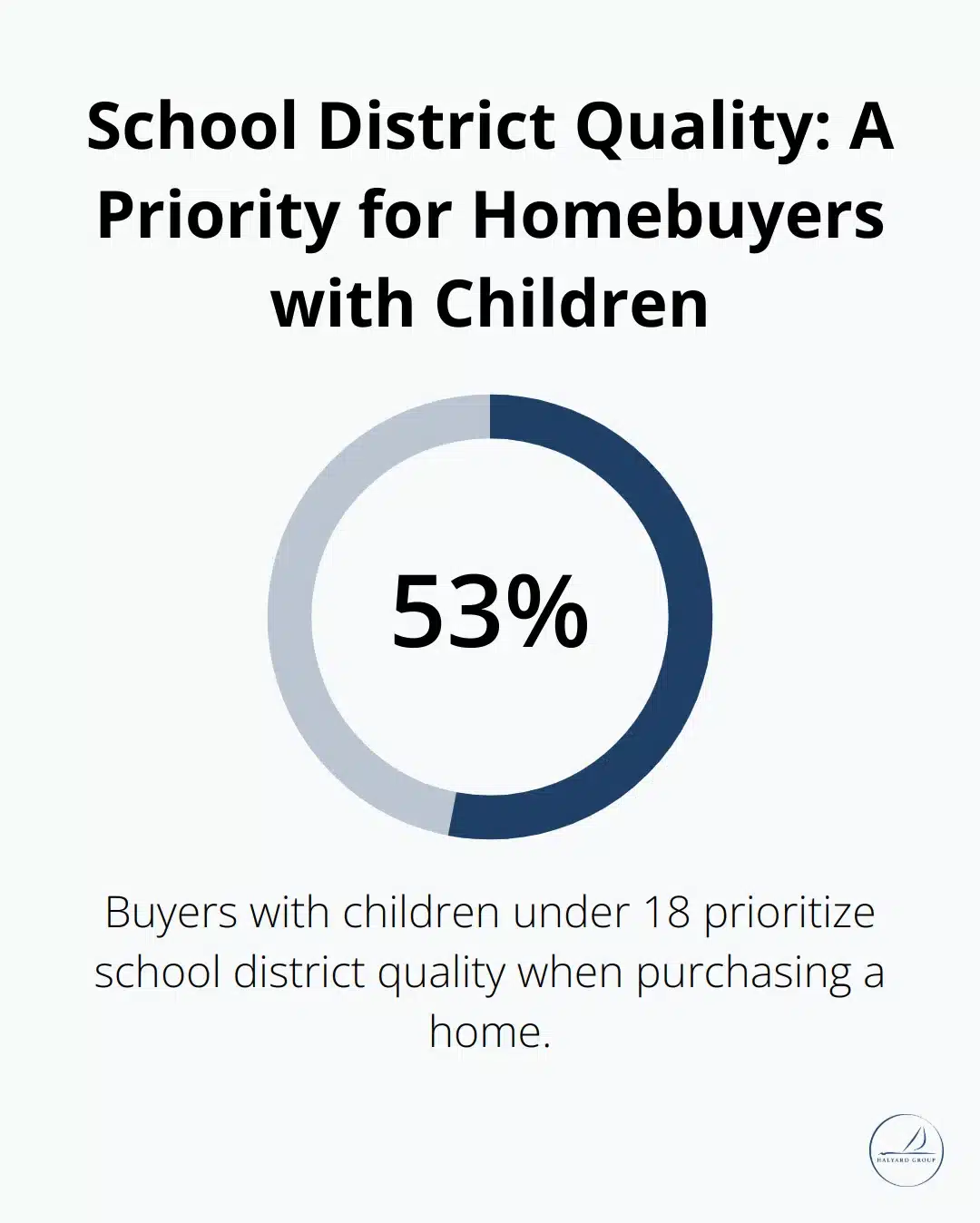Buying a home is a significant decision, and for many families, the goal is to find a place they can call their own for years to come. At The Halyard Group, we understand the importance of aligning on long-term home goals.
This blog post will guide you through the process of determining if your current house is truly your forever home. We’ll explore key factors to consider and how to overcome common challenges in finding the perfect long-term residence for your family.
What Are Your Family’s Long-Term Home Goals?
Space Requirements: Now and Later
When you plan for a forever home, you must align your family’s long-term goals with your housing choices. This process requires a careful evaluation of your current situation and future aspirations.
Start by assessing your current space needs. How many bedrooms do you need? Is your kitchen large enough for family gatherings? Do you need a home office or a playroom? Then, project these needs into the future. If you plan to have more children or expect elderly parents to move in, you’ll need to account for additional bedrooms and living areas.
A study by the National Association of Home Builders found that first-time buyers decreased to 24% of the market share, marking the lowest share since NAR began collecting the data in 1981.
Lifestyle Changes and Family Growth
Consider how your lifestyle might evolve. If you plan to work from home more often, a dedicated office space becomes essential. For growing families, proximity to good schools often tops the priority list. Fifty-three percent of buyers with children in the home under the age of 18 years said the quality of the school districts is an important factor when purchasing a home.

Think about your hobbies and interests too. If you enjoy gardening, a home with a large yard might suit you best. For fitness enthusiasts, a basement that converts into a home gym could prove valuable.
Location and Community Amenities
Location plays a significant role in long-term satisfaction with a home. Evaluate factors like commute times, access to public transportation, and proximity to amenities (such as parks, shopping centres, and healthcare facilities).
Community features also matter. Do you prefer a quiet suburban neighbourhood or a bustling urban area? Are there community centres, libraries, or sports facilities nearby? These factors can greatly impact your quality of life and deserve careful consideration.
Creating Your Home Wish List
To find a property that truly meets your needs, create a detailed list of must-haves and nice-to-haves. Prioritize them based on your family’s unique situation and future plans. This approach will guide your home search and help you make a decision that aligns with your long-term vision for your family’s life.
As you contemplate these long-term goals, you’ll need to consider several key factors that can make or break your decision. Let’s explore these crucial elements in the next section to ensure you make an informed choice for your forever home.
What Makes a Home Future-Proof?
Financial Sustainability for Long-Term Homeownership
When you select a forever home, you must consider factors that ensure your property remains suitable for years to come. Financial sustainability stands as a top priority. Higher financial returns for investors are frequently achieved by high-performing sustainable assets because they command premium rents, draw tenants more quickly, and have lower vacancy rates. However, you must balance potential investment gains with affordability.
Look beyond the initial purchase price. Include property taxes, insurance, maintenance costs, and potential renovations in your calculations.
Consider the home’s resale value, even if you plan to stay indefinitely. Neighbourhoods with good schools, low crime rates, and easy access to amenities tend to maintain or increase in value.
Adapting Your Home for the Future
A forever home should accommodate your needs as you age. Search for single-story layouts or homes with a master bedroom on the ground floor. Wide doorways and hallways, lever-style door handles, and step-free entrances enhance accessibility.
More than one out of four older people falls each year, but less than half tell their doctor. Falling once doubles your chances of falling again. You can significantly reduce fall risks by installing grab bars in bathrooms and ensuring good lighting throughout the house.

Energy Efficiency and Environmental Impact
Energy-efficient homes not only reduce your carbon footprint but also save money in the long run. Natural Resources Canada states that ENERGY STAR certified homes are at least 20% more energy efficient than homes built to code.
Search for homes with double-pane windows, proper insulation, and energy-efficient appliances. Solar panels can prove a worthwhile investment, with the average Canadian household saving between $900 – $3000 per year on electricity fees.
Location and Community Support
Proximity to essential services becomes increasingly important as families grow and age. The American Planning Association emphasizes the importance of walkable communities, which provide easy access to schools, healthcare facilities, and social support networks.
Research shows that living within a mile of a grocery store can increase your home’s value by up to 20% (according to real estate data company ATTOM Data Solutions). Similarly, homes near high-quality schools typically command a premium and maintain their value better over time.
As you weigh these factors in your search for a future-proof home, you’ll likely encounter challenges along the way. In the next section, we’ll explore common obstacles families face when searching for their forever home and provide strategies to overcome them.
Navigating the Forever Home Search
Prioritizing Needs Over Wants
The search for a forever home often requires tough decisions. You must distinguish between needs and wants. While a home theatre or sprawling backyard might appeal, these features often come at the expense of more important elements like location or financial sustainability.
To address this challenge, create two separate lists: one for absolute necessities and another for desired features. Rank each item based on its importance to your family’s long-term happiness and functionality. This exercise clarifies your priorities and simplifies decision-making when faced with trade-offs.
Nine factors, including money, location, environment, neighbourhood, and infrastructural amenities, influence long-term satisfaction in housing purchase decisions.

Tackling Market Challenges
Competitive real estate markets make finding your forever home difficult. High prices, bidding wars, and low inventory can frustrate and consume time.
To overcome these challenges, expand your search to up-and-coming neighbourhoods. These areas often offer better value and have significant appreciation potential. The Urban Land Institute’s Emerging Trends in Real Estate report describes the impact of social and political trends on real estate and explains how locational preferences are changing.
Another strategy involves quick action when you find a suitable property. Obtain mortgage pre-approval, organize your finances, and prepare to make a competitive offer. The Halyard Group provides invaluable assistance in this regard. Let us help you position yourself as a strong buyer in a competitive market.
Assessing Renovation Potential
The perfect forever home isn’t always move-in ready. Assessing a property’s renovation potential can expand your options, but you must approach this realistically.
Before considering a fixer-upper, request a thorough home inspection to understand necessary repairs. Factor these costs into your budget, and prepare for unexpected expenses.
Evaluate the home’s structural integrity, potential for adding square footage, and any zoning restrictions that might limit your renovation plans. Extensive renovations can consume time and create stress, so weigh whether the end result justifies the effort. The Renovator’s Technical Guide provides a whole new way of approaching renovation projects using the House-As-A-System approach.
Balancing Emotional and Practical Considerations
Emotions often play a significant role in home buying decisions. You might fall in love with a property’s charm or feel an instant connection to a neighbourhood. While these feelings are valid, they shouldn’t overshadow practical considerations.
Try to maintain objectivity by creating a scoring system for each property you view. Rate homes based on your predetermined criteria (such as location, size, and condition). This approach helps balance emotional pull with logical assessment.
Seeking Professional Guidance
Navigating the complexities of finding a forever home can overwhelm even the most prepared buyers. Professional real estate agents (like those at The Halyard Group) offer valuable insights, market knowledge, and negotiation skills.
These experts can help you identify properties that match your long-term goals, even if they don’t immediately catch your eye. They also provide access to off-market listings and can offer advice on potential resale value, an important consideration even for a “forever” home.
Final Thoughts
Choosing a forever home requires careful consideration of your family’s long-term home goals. You must balance current needs with future aspirations to ensure your chosen property adapts to your evolving lifestyle. Financial sustainability forms the foundation of this decision, so evaluate your budget thoroughly and consider all associated costs.
Location significantly impacts your family’s quality of life. Proximity to essential amenities, good schools, and healthcare facilities affects your daily experiences and overall contentment. The community’s character and potential for growth also influence how well your chosen neighbourhood aligns with your family’s values and aspirations.
Seeking professional guidance proves invaluable when navigating complex real estate markets. The Halyard Group specializes in helping families in the Greater Toronto Area upsize to larger homes. Their personalized approach and comprehensive support ensures their team can help you find a home that meets your unique needs and long-term goals.





